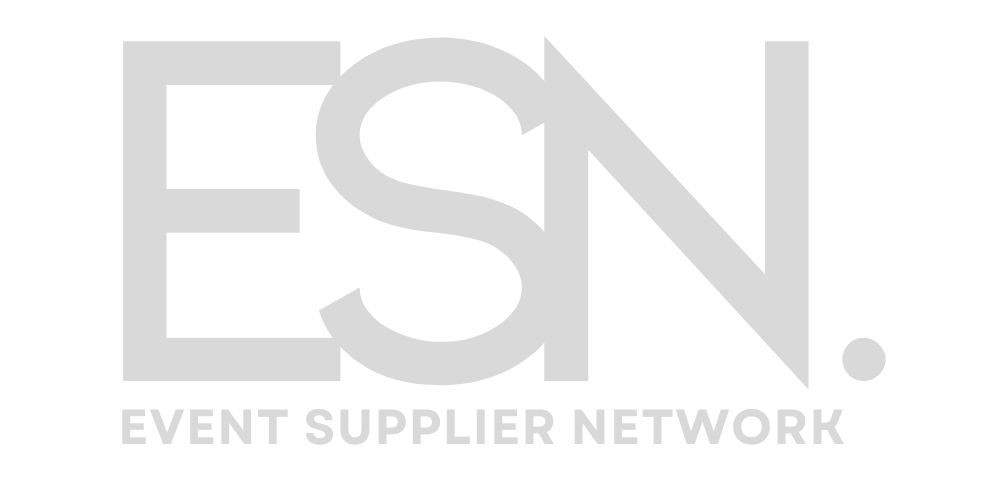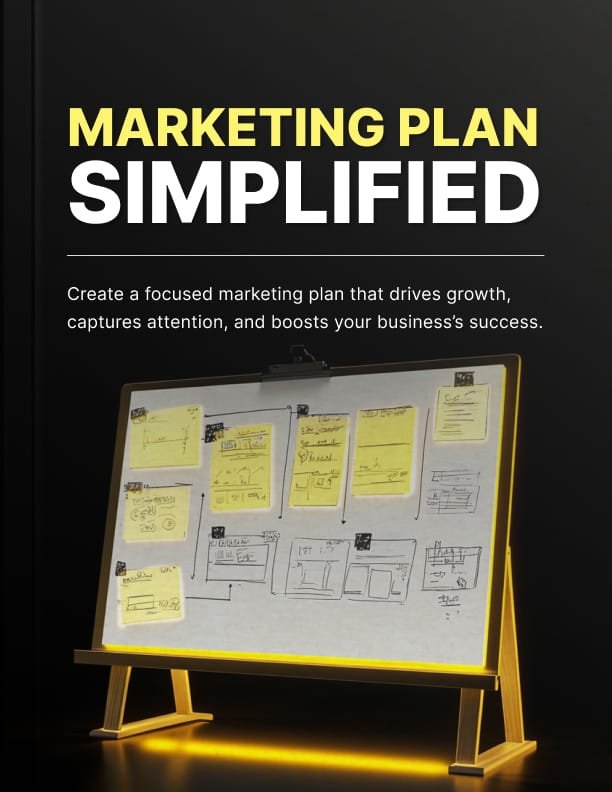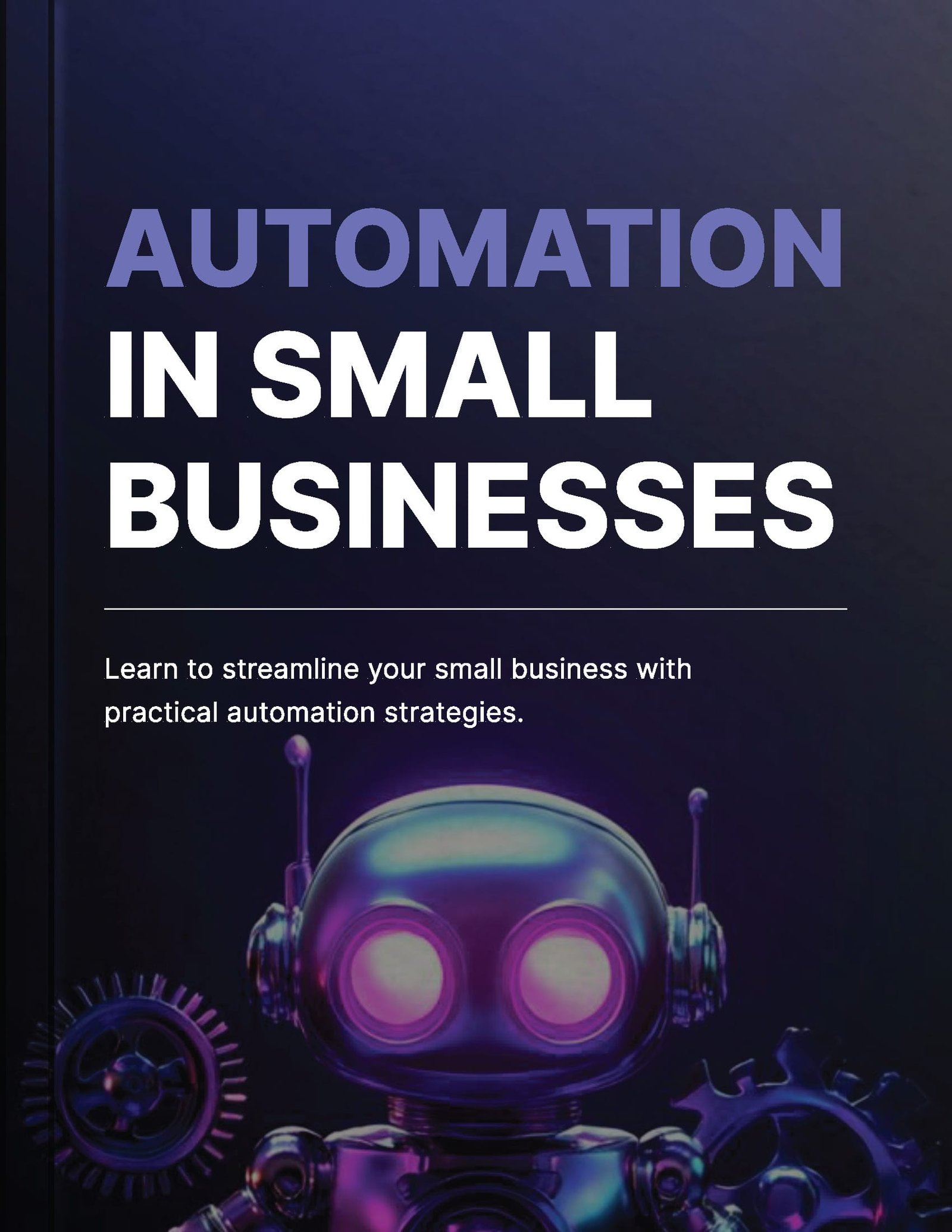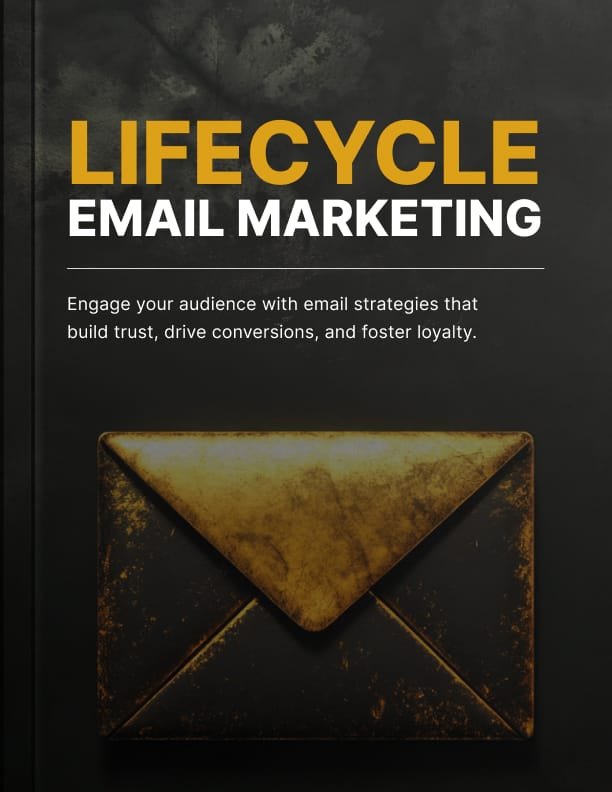INTRODUCTION
Navigating the world of marketing can often feel like wandering through a maze. As an entrepreneur or small business owner, you know firsthand the challenges of cutting through the clutter and reaching your customers effectively. It’s easy to get lost in the countless channels, tactics, and changing trends – leaving you feeling overwhelmed and unsure of the best path forward.
| This isn’t about working harder; it’s about working smarter. |
This course offers a refreshingly straightforward solution. Within this course, you’ll discover a clear, one-page marketing plan that distills strategy into a powerful tool to drive your efforts with precision. Unlike other marketing guides, this is your practical resource for crafting a strategy that’s unique to your business.
Imagine starting each day with clarity, knowing exactly who your customers are and how to engage them. Your brand voice resonates across platforms, attracting loyal followers. Instead of random, costly tactics, you’re making informed choices that align with clear, measurable goals. This isn’t about rigid formulas; it’s about creating a flexible plan that evolves with your business and the market.
By the last page, you’ll have the tools to transform your marketing and propel your business to new heights. You’ll craft a unique value proposition, map your customer journey, and identify key touchpoints to leave a lasting impact. Each chapter guides you with examples, exercises, and actionable steps, so you can confidently implement your plan with purpose.
Get ready to stand out. Visualize the satisfaction of seeing your inbox buzzing with new leads, engagement growing, and revenue climbing. This is the outcome when you apply these principles. The best part? This isn’t about working harder; it’s about working smarter. Say goodbye to overwhelm and hello to a focused, efficient strategy tailored to your business.
Are you ready to transform your marketing and drive your business to new heights? Open this book, and take your first step towards a streamlined, successful future.
IDENTIFY YOUR IDEAL CUSTOMER AND STAND OUT
You’re about to uncover the power of precision marketing. In this chapter, you’ll learn how to pinpoint your ideal customer and create a unique brand identity that sets you apart from the competition. By the end, you’ll have the tools to focus your marketing efforts like a laser, reaching the right people with the right message.
Understanding Your Ideal Customer
Imagine throwing darts blindfolded. That’s what marketing without knowing your ideal customer feels like. But when you remove that blindfold, your aim improves dramatically. That’s the power of customer persona research.
You might think you know your customers, but let’s dig deeper. Start by examining your current customer base. Who are your most profitable clients? Which ones rave about your products or services? These are the people you want to clone.
To build a detailed customer persona, you’ll need to gather information from various sources. Pay attention to customer interactions, noting the questions they ask, their pain points, and the language they use. This gives you invaluable insights into their needs and preferences. Create targeted surveys to learn more about your customers’ demographics, interests, and purchasing habits. Tools like SurveyMonkey or Google Forms can help you create and distribute these surveys easily. Utilize social media analytics platforms like Facebook Insights and Twitter Analytics to gather information about your followers’ demographics and behaviors. Use website analytics tools like Google Analytics to understand who’s visiting your site, what content they’re engaging with, and how they’re finding you. Analyze your sales records to identify patterns in purchasing behavior, customer lifetime value, and product preferences.
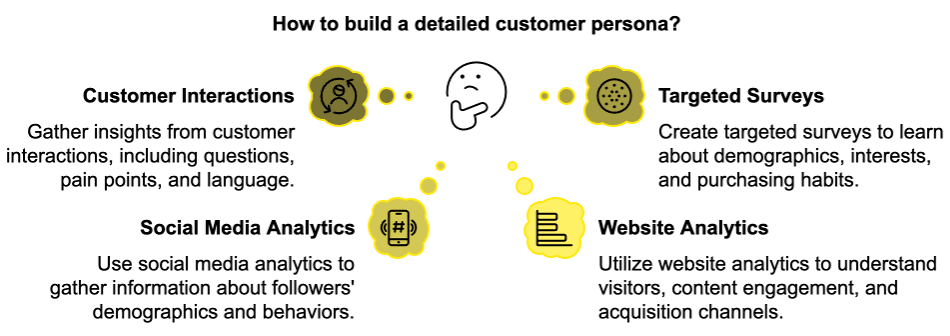
Armed with this information, you can create a detailed customer persona. Here’s an example:
Meet Sarah, the Busy Professional:
- Age: 35
- Occupation: Marketing Manager
- Income: £65,000/year
- Location: Urban area
- Interests: Fitness, healthy eating, professional development
- Pain Points: Limited time, work-life balance, staying up-to-date with industry trends
- Purchasing Habits: Researches extensively before buying, values quality and convenience
- Preferred Communication Channels: Email, LinkedIn
Creating this detailed persona allows you to tailor your marketing messages, product offerings, and communication strategies to resonate with Sarah and others like her. But don’t stop at one persona. Most businesses have multiple ideal customer types. Create 2-3 personas to represent your core customer segments. This allows you to craft targeted marketing campaigns that speak directly to each group’s unique needs and preferences. These personas aren’t set in stone. With the growth of your business and shifts in market conditions, it’s essential to revisit and refine your personas consistently. This ensures your marketing efforts remain relevant and effective.
Crafting Your Unique Value Proposition (UVP)
Now that you know who your ideal customers are, it’s time to communicate why they should choose you over your competitors. This is where your Unique Value Proposition (UVP) comes into play. Your UVP is the heart of your brand’s identity. It’s a clear statement that describes the benefit of your offer, how you solve your customer’s needs, and what distinguishes you from the competition. A strong UVP is clear and concise, communicates specific results, explains how you’re different, and can be read and understood in about 5 seconds.
Let’s break down the process of crafting your UVP:
- Identify Your Target Market: Use the insights from your customer personas to ensure your UVP speaks directly to your ideal customers.
- Explain the Problem You Solve: Be specific about the challenge your customers face.
- List the Key Benefits: Focus on the outcomes your customers will experience.
- Define What Makes You Unique: This is your “secret sauce.” What do you offer that your competitors don’t?
- Combine and Refine: Bring all these elements together into a clear, compelling statement.
Here’s a formula you can use: For [target market], [your company name] provides [key benefit] by [how you do it uniquely].
Let’s look at an example: “For busy professionals who value their time and health, FitMeal delivers chef-prepared, personalized meals straight to your door, using locally-sourced ingredients and AI-powered nutrition planning.”
This UVP clearly identifies the target market (busy professionals), the key benefit (convenient, healthy meals), and what makes the service unique (personalized, locally-sourced, AI-powered).
Once you’ve crafted your UVP, test it with some of your ideal customers. Does it resonate with them? Does it accurately reflect what your business offers? Refine it based on their feedback.
Implementing Your UVP and Differentiating Your Brand
Your UVP shouldn’t just live on your website’s homepage. It should inform all aspects of your marketing and branding. Feature your UVP prominently on your homepage and about page. Use it to guide your site’s content and design. Reflect your UVP in your social media bios and the content you share. Ensure your UVP is reflected in your brochures, business cards, and other marketing collateral. Use your UVP as a guidepost when developing new products or services. Train your team to embody your UVP in every customer interaction. Center your ad copy around your UVP to create consistent, compelling messages.
While your UVP is a crucial part of brand differentiation, there are other strategies you can employ to stand out in a crowded market. Develop a distinctive brand personality with a unique voice and visual identity that reflects your UVP and resonates with your ideal customers. Create a memorable customer experience that aligns with your brand values and UVP. Continuously innovate and improve your products or services based on customer feedback and market trends. Position yourself as a thought leader in your field through content marketing, speaking engagements, or industry collaborations. Align your brand with causes that matter to your ideal customers and reflect your company values through corporate social responsibility initiatives. Remember, differentiation isn’t just about being different—it’s about being meaningfully different in ways that matter to your customers.
To ensure your UVP and differentiation strategies are effective, you need to measure their impact. Here are some key metrics to track:
| Metric | Description |
| Brand Awareness | Use surveys or social media listening tools to gauge familiarity with your brand |
| Customer Acquisition Cost (CAC) | Should decrease over time if UVP is effective |
| Customer Lifetime Value (CLV) | Should increase with a strong brand and clear UVP |
| Net Promoter Score (NPS) | Measures likelihood of customers recommending your brand |
| Conversion Rates | Monitor impact of UVP across different marketing channels |
| Market Share | Track to see if differentiation strategies are gaining ground on competitors |
Regularly analyzing these metrics allows you to refine your UVP and differentiation strategies, ensuring they resonate with your ideal customers and drive business growth. Moving forward with your marketing efforts, keep your ideal customer personas and UVP at the forefront of your mind. They’ll serve as your North Star, guiding your decisions and helping you create marketing messages that truly connect with your target audience. In the next chapter, we’ll explore how to develop a consistent and engaging brand voice that brings your UVP to life across all your marketing channels. You’ll learn how to create a brand personality that resonates with your ideal customers and sets you apart from the competition.
CRAFTING A CONSISTENT AND ENGAGING BRAND VOICE
Your brand voice is the personality and emotion behind your company’s communications. It’s how you speak to your customers, and it’s a critical component of your overall brand identity. In this chapter, you’ll discover how to develop a brand voice that resonates with your ideal customers and sets you apart from the competition.
Understanding the Importance of Brand Voice
Think about your favorite brands. What do they sound like when they communicate with you? Are they friendly and casual, or professional and authoritative? Do they use humor, or are they always serious? These characteristics make up their brand voice, and they play a crucial role in how you perceive and connect with these companies.
Your brand voice is more than just the words you use. It’s the tone, style, and personality that come through in all your communications. A consistent brand voice helps you build trust with your audience, differentiate yourself from competitors, create emotional connections with customers, reinforce your brand identity, and improve customer retention. According to a 2023 study by the Content Marketing Institute, 81% of marketers agree that a consistent brand voice across all channels is crucial for building brand trust. This statistic underscores the importance of developing and maintaining a strong brand voice.
Defining Your Brand Voice
To create a brand voice that resonates with your ideal customers, you need to start by defining it clearly. Begin by reviewing your brand values, as your brand voice should reflect your company’s core values. Next, analyze your audience using the customer personas you developed in Chapter 1 to understand their preferences and communication styles. Conduct an audit of your current communications, looking at your existing marketing materials, social media posts, and customer service interactions to identify the tone you’re already using and whether it aligns with your brand values and audience preferences. Create a brand voice chart that outlines your brand voice characteristics, including descriptions, do’s, and don’ts for each characteristic. Finally, test and refine your brand voice by trying it out in various communications and gathering feedback from your team and customers.
Your brand voice should be flexible enough to adapt to different situations while maintaining its core characteristics. For example, your tone might be more serious when addressing a customer complaint than when sharing a fun social media post, but the underlying voice should remain consistent.
Implementing Your Brand Voice Across Channels
Once you’ve defined your brand voice, it’s time to implement it across all your marketing channels. Consistency is key here. Your brand should sound the same whether a customer is reading your website, scrolling through your social media, or chatting with your customer service team. To maintain consistency, create a comprehensive brand voice guide that outlines your brand voice, provides examples, and includes do’s and don’ts. Share this with everyone in your organization who communicates with customers or creates content. Conduct workshops to help your team understand and implement your brand voice, especially for customer-facing roles like sales and customer service. Create templates for common communications that embody your brand voice to help maintain consistency, especially for team members who aren’t natural writers. Regularly audit your communications across all channels to ensure they’re aligning with your brand voice and identify areas for improvement. While your core brand voice should remain consistent, you may need to adapt it slightly for different platforms. For example, your tone on LinkedIn might be slightly more professional than on Instagram, but the underlying voice should still be recognizably your brand.
The Power of Storytelling in Brand Voice
Storytelling is a powerful tool for bringing your brand voice to life. Humans are wired to respond to stories – they help us connect emotionally and remember information better. Incorporating storytelling into your brand communications makes your brand more relatable and memorable, creating stronger connections with your audience. Share your origin story, telling how your company started and what problem you were trying to solve. Use customer success stories to showcase how your products or services have helped real customers, helping potential customers see themselves benefiting from your brand. Give your audience a peek behind the curtain with behind-the-scenes content about your team, processes, or company culture. Instead of just listing features, tell the story of why you created a product and how it solves a problem for your customers. Remember, these stories should be told in your brand voice, reinforcing your brand identity and connecting with your audience.
The Key to an Effective Brand Voice
Authenticity is more important than ever in connecting with your audience. Customers can spot insincerity a mile away, and they’re drawn to brands that feel genuine and transparent. Your brand voice plays a crucial role in conveying authenticity. To maintain authenticity in your brand voice, be consistent across all touchpoints. If you’re friendly and casual on social media but formal and distant in your email communications, it can create a disconnect for your customers. When things go wrong, own up to it in your brand voice. A sincere apology that sounds like it’s coming from a real person, not a corporate robot, can go a long way in maintaining trust. Don’t be afraid to let your brand’s personality shine through. If humor is part of your brand voice, use it appropriately. If you’re passionate about certain causes, express that passion. Use your brand voice to communicate openly about your processes, policies, and values. This transparency builds trust with your audience. Engage with your audience in your brand voice by responding to comments, asking for feedback, and showing that you’re not just broadcasting messages but having a two-way conversation.
Evolving Your Brand Voice
Your brand voice isn’t set in stone. As your business grows and evolves, your brand voice may need to evolve too. Maybe you’re expanding into new markets, or your customer base is changing. Perhaps you’ve refined your brand values or your unique value proposition. In these cases, it’s important to revisit and potentially update your brand voice. Schedule regular reviews of your brand voice to ensure it’s still aligned with your brand values and resonating with your audience. Gather feedback from your customers and employees on your communications to determine if your brand voice feels authentic and appealing to them. Analyze engagement metrics across your channels to identify certain types of content or communications that perform particularly well, which might give you insights into how your brand voice is resonating. If you decide to make changes to your brand voice, implement them gradually to avoid jarring your audience. For significant changes, consider communicating this to your audience, explaining why you’re evolving and how it will benefit them. The goal is to maintain a brand voice that authentically represents your brand and resonates with your audience.
| Brand Voice Characteristic | Description | Do | Don’t |
| Friendly | Approachable and welcoming | Use casual language, address the reader directly | Use overly formal or stuffy language |
| Expert | Knowledgeable and authoritative | Share insights and data, use industry terms (explained simply) | Use jargon without explanation, make unsubstantiated claims |
| Optimistic | Positive and solution-oriented | Focus on solutions, use positive language | Dwell on problems, use negative or pessimistic language |
While developing your brand voice, always keep your ideal customer personas and unique value proposition in focus. Your brand voice should be a natural extension of these elements, helping you communicate your value to your target audience in a way that feels authentic and engaging. In the next chapter, we’ll explore how to set smart marketing goals and choose the most impactful channels for reaching your audience. You’ll learn how to align your marketing efforts with your business objectives and make data-driven decisions about where to focus your resources. Armed with a strong brand voice and clear goals, you’ll be well on your way to creating a powerful, effective marketing strategy.
SMART GOALS AND IMPACTFUL CHANNELS
You’re ready to take your marketing efforts to the next level. In this chapter, you’ll learn how to set goals that drive your business forward and select the most effective channels to reach your audience. You’ll finish with a clear path to success and the tools needed to make informed decisions about where to direct your marketing efforts.
The Power of SMART Goals
Goal-setting is the compass that guides your marketing efforts. Without clear, measurable goals, you’re essentially navigating without a map. That’s where SMART goals come in. SMART is an acronym that stands for:
- Specific
- Measurable
- Achievable
- Relevant
- Time-bound
SMART goals are essential for effective marketing strategies. They provide clarity, focus, and a way to measure progress. When setting SMART goals, consider your overall business objectives, current marketing metrics, and areas for improvement. It’s better to have a few well-defined goals than a long list of vague objectives. Aim for 3-5 key marketing goals that will have the most significant impact on your business.
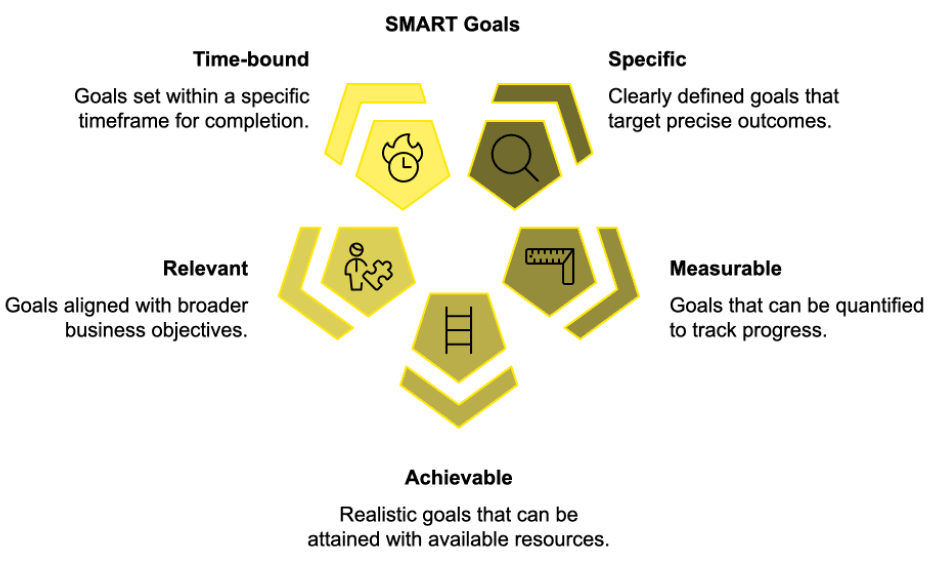
Here’s an example of a SMART marketing goal:
“Increase our email newsletter subscribers by 30% (from 10,000 to 13,000) within the next six months by implementing a pop-up sign-up form on our website and running a social media campaign.”
This goal is specific (increase email subscribers), measurable (30% increase), achievable (with defined tactics), relevant (growing the email list can support various business objectives), and time-bound (within six months).
Aligning Marketing Goals with Business Objectives
Your marketing goals shouldn’t exist in a vacuum. They should directly support your broader business objectives. This alignment ensures that your marketing efforts are driving real business results, not just vanity metrics.
To align your marketing goals with business objectives, start by reviewing your company’s top priorities. Are you looking to increase revenue, expand into new markets, or improve customer retention? Identify marketing’s role in supporting these objectives. For example, if the goal is to increase revenue, marketing might focus on generating more qualified leads or improving conversion rates. Translate these broad ideas into SMART marketing goals. For instance, if the business objective is to increase revenue by 15%, a marketing goal might be to “Generate 20% more qualified leads for the sales team within the next quarter.”
Create a clear connection between each marketing goal and a specific business objective. This alignment helps justify your marketing budget and demonstrate the ROI of your activities. Finally, communicate your marketing goals with other teams, especially sales and product development, to ensure everyone is working towards the same objectives.
Choosing the Right Marketing Channels
With your goals set, it’s time to decide where to focus your marketing efforts. The key is to be where your customers are. Remember those customer personas you created in Chapter 1? They’re going to be invaluable here. Start by listing all potential marketing channels, including social media platforms, email marketing, content marketing, pay-per-click advertising, search engine optimization (SEO), traditional advertising, public relations, events and trade shows, influencer marketing, and affiliate marketing.
Consider each channel through the lens of your ideal customer:
- Where do they spend their time?
- How do they prefer to receive information?
- What types of content do they engage with?
For example, if your target audience is young professionals, LinkedIn and industry-specific podcasts might be more effective than Facebook or TikTok. If you’re targeting retirees, Facebook and email marketing might be better choices. Don’t forget to consider the nature of your product or service. Visual products often perform well on platforms like Instagram or Pinterest, while complex B2B services might require longer-form content like whitepapers or webinars. It’s also important to think about your resources. Each channel requires time, effort, and often money to manage effectively. It’s better to excel on a few channels than to spread yourself too thin across many.
Analyzing Channel Performance and Optimization
Once you’ve selected your channels, it’s crucial to continually analyze their performance. This allows you to double down on what’s working and adjust or abandon what isn’t. Key metrics to track include:
- Engagement rate, follower growth, and conversions forsocial media.
- Open rate, click-through rate (CTR), and list growth rate foremail marketing.
- Page views, time on page, and conversions for content marketing.
- Click-through rate (CTR), cost per click, and return on ad spend (ROAS) for pay-per-click advertising.
- Organic traffic, keyword rankings, and domain authority for SEO.
Use tools like Google Analytics, social media insights, and email marketing software to track these metrics. Set up regular reporting to monitor your progress towards your goals.
Marketing is not a set-it-and-forget-it activity. To get the best results, you need to constantly test and optimize your strategies. A/B testing (also known as split testing) is a powerful tool for improving your marketing performance. Here’s how it works: Choose one element to test (e.g., email subject line, ad headline, call-to-action button color), create two versions (A and B) with only that one element different, show each version to a similar audience, measure the results, and implement the winning version.
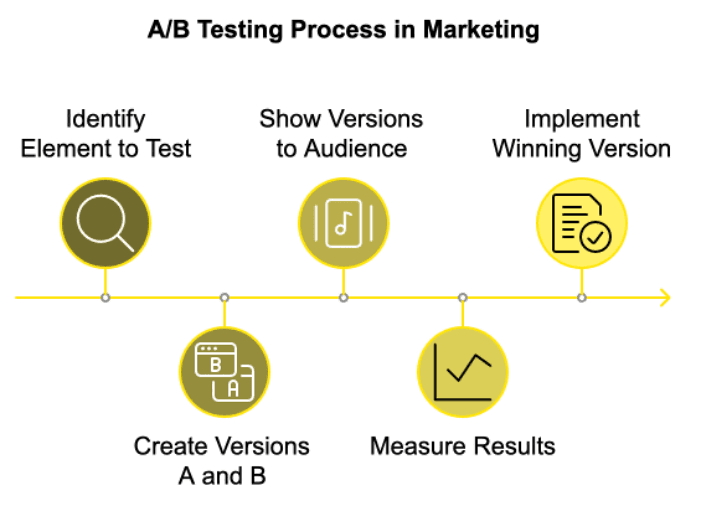
You can A/B test almost anything: email subject lines, ad copy, landing page designs, social media post formats, and more. The key is to test one element at a time so you can clearly attribute any difference in performance. Start with elements that have the biggest potential impact. For example, testing different offers or value propositions will likely yield more significant results than testing button colors.
Data-Driven Decisions and Adaptability
You now have access to more marketing data than ever, offering valuable insights into your audience’s behaviors and preferences. The challenge is turning that data into actionable insights. Focus on key performance indicators (KPIs) that directly relate to your SMART goals. Look for trends over time to get a more accurate picture of your performance. Segment your data by customer segments, channels, or campaigns to get more detailed insights. Use data visualization to spot patterns and trends more easily than raw numbers. Combine quantitative and qualitative data to understand not just what is happening, but why it’s happening. Most importantly, act on your insights by regularly reviewing your data and using it to inform your marketing strategies.
The marketing landscape is constantly evolving. New platforms emerge, consumer behaviors shift, and global events can dramatically change the business environment overnight. To succeed in the long term, you need to be adaptable. Stay informed about industry trends and changes in your target market. Follow marketing blogs, attend webinars, and network with other professionals in your field. Be open to trying new channels or strategies, but always test them against your existing methods before making a full switch. Most importantly, keep your focus on your customers. As long as you’re meeting their needs and providing value, you’ll be able to adapt to whatever changes come your way.
| Channel | Key Metrics | Tools for Analysis |
| Social Media | Engagement rate, Follower growth, Click-through rate, Conversions | Platform insights, Social media management tools |
| Email Marketing | Open rate, Click-through rate, Conversion rate, List growth rate | Email marketing software |
| Content Marketing | Page views, Time on page, Bounce rate, Conversions | Google Analytics, Content management systems |
| PPC Advertising | Click-through rate, Cost per click, Conversion rate, Return on ad spend | Google Ads, Bing Ads |
| SEO | Organic traffic, Keyword rankings, Backlinks, Domain authority | Google Analytics, SEO tools (e.g., SEMrush, Ahrefs) |
When implementing your marketing plan, keep in mind that it’s a living document. Regularly review your goals, assess your channel performance, and be ready to adjust your strategies as needed. With clear goals, well-chosen channels, and a data-driven approach, you’re well on your way to marketing success. Keep experimenting, keep learning, and most importantly, keep focusing on providing value to your customers. That’s the surest path to long-term marketing success.
CUSTOMER JOURNEY MAPPING AND PLAN IMPLEMENTATION
Understanding the Customer Journey
The customer journey is the path a potential customer takes from first becoming aware of your brand to making a purchase and beyond. Understanding this journey enables you to craft targeted marketing strategies that guide customers through each stage, ultimately boosting conversions and fostering customer loyalty. The typical customer journey consists of five main stages:
- Awareness
- Consideration
- Decision
- Retention
- Advocacy
To map your customer journey, start by putting yourself in your customers’ shoes. Use your customer personas from Chapter 1 to guide you. For each stage of the journey, ask yourself what the customer is thinking and feeling, what actions they’re taking, what questions they have, what barriers might prevent them from moving to the next stage, and what touchpoints they have with your brand. Create a visual representation of this journey, either using software like Miro or Lucidchart, or simply with pen and paper. This visual map will help you identify opportunities to improve the customer experience and guide your marketing efforts.
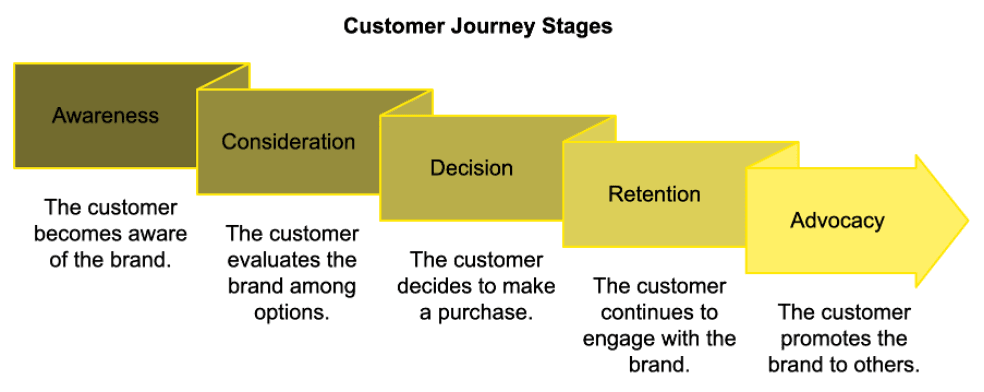
Identifying Touchpoints and Pain Points
Touchpoints are all the places where your customer interacts with your brand, both online and offline. These might include your website, social media profiles, email communications, advertising, customer service interactions, in-store experiences, and product packaging. For each touchpoint, consider how you can optimize the customer experience. Is your website easy to navigate? Are your social media profiles providing valuable content? Is your customer service team responsive and helpful?
Pain points are the challenges or frustrations your customers experience during their journey. These could be related to your product, your marketing, or the broader problem your product solves. Common pain points include lack of information about your product or service, complicated purchasing process, long wait times for customer service, difficulty using the product, and unexpected costs or fees. Identifying these pain points allows you to address them proactively in your marketing and product development. For example, if customers are struggling to understand how to use your product, you might create a series of tutorial videos or improve your product documentation.
Crafting Strategies for Each Stage of the Journey
Now that you understand your customer’s journey, it’s time to create targeted strategies for each stage. For the awareness stage, create informative blog posts and social media content that addresses your customers’ pain points, use SEO strategies to improve your visibility in search results, and run targeted advertising campaigns to reach potential customers. In the consideration stage, offer detailed product information and comparison guides, provide case studies and customer testimonials, and use retargeting ads to stay top-of-mind with interested prospects. For the decision stage, offer free trials or demos, provide clear pricing information and highlight your unique value proposition, and use email marketing to nurture leads and address any final objections. In the retention stage, send onboarding emails to help new customers get started, provide excellent customer support, and regularly ask for feedback and act on it. Finally, for the advocacy stage, implement a referral program to incentivize word-of-mouth marketing, feature customer success stories in your marketing, and engage with customers on social media and highlight their positive experiences. Remember, the goal is to create a seamless experience that guides the customer from one stage to the next, addressing their needs and concerns along the way.
Creating Your Implementation Plan
With your customer journey mapped and strategies outlined, it’s time to create a concrete implementation plan. This plan should detail exactly what needs to be done, by whom, and when. Here’s how to create an effective implementation plan:
- Break down your strategies into specific tasks
- Assign responsibilities
- Set deadlines
- Prioritize tasks
- Create a timeline
- Establish key performance indicators (KPIs)
- Plan for regular reviews
Here’s an example of how this might look for a social media marketing strategy:
| Task | Responsible | Deadline | Priority | KPI |
| Create content calendar | Marketing Manager | July 1 | High | N/A |
| Design social media templates | Graphic Designer | July 15 | Medium | N/A |
| Write and schedule posts | Social Media Coordinator | Ongoing | High | Engagement rate |
| Run paid social campaign | Marketing Manager | Aug 1 – Aug 31 | Medium | CTR |
| Analyze results | Marketing Manager | Sept 5 | High | N/A |
Setting a Realistic Budget and Adapting to Change
Your marketing budget will play a crucial role in determining which strategies you can implement and to what extent. Determine your overall marketing budget, typically a percentage of your revenue or projected revenue. For small businesses, this often ranges from 7-8% of gross revenue. Allocate funds to different marketing channels based on your chosen strategies and the potential ROI of each channel. Factor in one-time costs, build in flexibility, and review and adjust regularly.
| Marketing is an investment, not just an expense. |
Every dollar spent should be working towards achieving your business goals.
Even the best-laid plans can go awry. Implementing your marketing plan may come with challenges and unexpected changes along the way. Stay informed about industry trends and changes in your target market. Monitor your metrics closely and be prepared to pivot if a strategy isn’t working. Learn from failures and celebrate successes. Foster a culture of innovation and plan for different scenarios. Staying adaptable and resilient will better equip you to navigate the ever-changing landscape of marketing. Keep in mind that marketing is an investment in your future growth, not just a current expense.
Measuring Success and Iterating
Implementing your marketing plan is not a one-time event, but an ongoing process of measurement, analysis, and improvement. Set up a system for regular reporting on your key metrics. Use data visualization tools to create dashboards that make it easy to understand your data at a glance. Continuously test different elements of your marketing, from email subject lines to ad copy to landing page designs. Regularly solicit feedback from your customers through surveys, interviews, or focus groups. Hold regular meetings with your team to discuss what’s working, what’s not, and brainstorm improvements. Keep an eye on what your competitors are doing and how it’s impacting your market share. While you should be making small adjustments constantly, set aside time each year for a more comprehensive review and planning session. The goal is continuous improvement. Each iteration of your marketing plan should be more effective than the last. As you implement your marketing plan, keep your focus on providing value to your customers. Gaining insight into their journey, addressing their pain points, and refining your approach will set you on the path to marketing success. Stay flexible, stay focused, and most importantly, keep learning and adapting. Your marketing plan is a living document that will evolve as your business grows and changes. Embrace this process, and you’ll be able to navigate whatever challenges come your way.
YOUR PATH TO EFFECTIVE MARKETING
The Power of Integration
Marketing isn’t just about running a few ads or posting on social media. It’s about creating a seamless experience for your customers across all touchpoints. This is where integration comes in. Integrated marketing communications ensure that all aspects of your marketing work together to deliver a consistent message and experience to your customers. Think about your favorite brands. Their marketing feels cohesive, whether you’re visiting their website, scrolling through their social media, or reading their email newsletter. This consistency builds trust and reinforces brand recognition. According to a 2023 study by Nielsen, brands with integrated marketing campaigns saw a 20% increase in brand awareness compared to those with disjointed efforts.
To achieve this level of integration, start by revisiting your unique value proposition (UVP) from Chapter 1. Your UVP should be the thread that ties all your marketing efforts together. Whether you’re writing a blog post, designing a social media ad, or crafting an email campaign, always ask yourself: “How does this reflect our UVP?” Next, ensure that your brand voice (which you developed in Chapter 2) is consistent across all channels. This doesn’t mean every piece of content should sound identical – remember, your brand voice should be flexible enough to adapt to different platforms and situations. But there should be a recognizable personality that shines through, whether you’re responding to a customer service inquiry or writing a whitepaper. Finally, make sure your visual branding is consistent. This includes your logo, color scheme, typography, and overall design aesthetic. Create a style guide that outlines these elements and share it with everyone involved in your marketing efforts, including external partners or agencies.
Leveraging Your Customer Journey Map
Your customer journey map, which you created in Chapter 4, is a powerful tool for guiding your integrated marketing efforts. Use it to identify opportunities for cross-channel marketing and to ensure you’re providing the right content at the right time. For example, let’s say you run an e-commerce store selling eco-friendly home goods. Your customer journey map might include stages like awareness, consideration, evaluation, purchase, post-purchase, and loyalty. For each stage of this journey, you can create targeted marketing efforts. In the awareness stage, create blog posts and social media content about the importance of sustainability in the home and run targeted ads to reach environmentally-conscious consumers. During the consideration stage, develop detailed product information pages that highlight the eco-friendly aspects of your products and create comparison guides that show how your products stack up against less sustainable alternatives. For the evaluation stage, implement a review system on your website and encourage customers to leave feedback. Create case studies or customer stories that showcase real-life experiences with your products. In the purchase stage, optimize your checkout process for ease of use and offer eco-friendly packaging options. For post-purchase, send follow-up emails with care instructions and tips for getting the most out of the product, and invite customers to join your sustainability community on social media. Finally, in the loyalty stage, implement a rewards program that incentivizes repeat purchases and referrals, and share user-generated content that showcases how customers are using your products in their homes. By aligning your marketing efforts with the customer journey, you ensure that you’re providing value at every stage and guiding potential customers towards a purchase decision.
Data-Driven Decision Making
You now have access to more marketing data than ever, giving you powerful insights to refine and elevate your strategies. The key is to use this data effectively to inform your marketing decisions. Here’s how to make data-driven decisions:
- Define Your Key Performance Indicators (KPIs)
These should align with the SMART goals you set in Chapter 3. For example, if your goal is to increase email subscribers by 30%, your KPIs might include email sign-up rate, newsletter open rate, and click-through rate.
- Set Up Tracking
Use tools like Google Analytics, social media insights, and your email marketing platform to track your KPIs. Make sure you’re tracking across all channels for a complete picture of your marketing performance.
- Analyze Regularly
Set aside time each week to review your metrics. Look for trends and patterns. Are certain types of content performing better than others? Are there particular times when your audience is most engaged?
- Test and Optimize
Use A/B testing to continuously improve your marketing efforts. Test elements like email subject lines, ad copy, landing page designs, and call-to-action buttons.
- Make Informed Decisions
Use your data to guide your marketing decisions. If your data shows that video content is outperforming static images on social media, for example, you might decide to invest more in video production.
Keep in mind that data is there to guide your choices, but it shouldn’t overshadow your knowledge of your brand and customers. Balance insights from data with a deep understanding of your audience to make well-rounded decisions.
Adapting to Change and Continuous Improvement
The marketing landscape is constantly evolving. New platforms emerge, consumer behaviors shift, and global events can dramatically change the business environment overnight. To succeed in the long term, you need to be adaptable. Stay informed about industry trends and changes in your target market. Follow marketing blogs, attend webinars, and network with other professionals in your field. Be open to trying new channels or strategies, but always test them against your existing methods before making a full switch. Most importantly, keep your focus on your customers. As long as you’re meeting their needs and providing value, you’ll be able to adapt to whatever changes come your way.
| The most effective marketing doesn’t feel like marketing to the customer; it feels like a helpful resource, a solution to a problem, or a delightful discovery. |
Marketing is not a “set it and forget it” activity. It requires continuous learning and improvement. Stay educated by taking online courses, attending marketing conferences, and reading industry publications to stay up-to-date on the latest marketing trends and techniques. Don’t be afraid to experiment and try new things in your marketing. Not every experiment will be successful, but each one is an opportunity to learn and improve. Keep an eye on what your competitors are doing and learn from their successes and failures. Regularly ask for feedback from your customers, your team, and even other marketers. Fresh perspectives can lead to new ideas and improvements. When a marketing campaign doesn’t perform as well as expected, take the time to understand why. These insights can inform your future strategies.
Building a Marketing-Oriented Culture
Effective marketing isn’t just the responsibility of the marketing department – it should be part of your entire company culture. Share your marketing goals and make sure everyone in your organization understands how their work contributes to these goals. Encourage customer-centric thinking and train all employees to consider how their work impacts the customer experience. Foster cross-departmental collaboration, especially between marketing and other departments like sales, product development, and customer service. Celebrate marketing successes and share them with the entire company. Create a culture where employees feel empowered to share ideas for improving marketing efforts.
As you implement your marketing plan, it’s worth considering the future of marketing. While it’s impossible to predict exactly what the marketing landscape will look like in the coming years, several trends are likely to shape the future. Artificial Intelligence and Machine Learning are already being used in marketing for tasks like personalization and predictive analytics, and their role is likely to grow. With the increasing popularity of voice assistants, optimizing for voice search will become more important. As consumers become more concerned about data privacy, marketers will need to find ways to personalize experiences while respecting privacy preferences. Sustainability and social responsibility are becoming increasingly important to consumers, so marketing that highlights a brand’s efforts in these areas is likely to become more crucial. Stay informed about these trends and consider how they might impact your marketing strategies in the future.
| Marketing Element | Key Considerations |
| Integration | Consistent UVP, brand voice, and visual branding across all channels |
| Customer Journey | Targeted marketing efforts for each stage of the journey |
| Data-Driven Decisions | Define KPIs, set up tracking, analyze regularly, test and optimize |
| Adaptability | Stay informed about trends, be open to new strategies |
| Continuous Improvement | Stay educated, experiment, learn from competitors, seek feedback |
| Marketing Culture | Share goals, encourage customer-centric thinking, foster collaboration |
| Future Trends | AI/ML, voice search, privacy concerns, sustainability |
Remember, the most effective marketing doesn’t feel like marketing at all to the customer. It feels like a helpful resource, a solution to a problem, or a delightful discovery. Strive to create marketing that your customers will appreciate and value. As you implement your marketing plan, there will be challenges and setbacks. But don’t get discouraged. Each challenge is an opportunity to learn and improve. Stay focused on your goals, keep your customer at the center of everything you do, and don’t be afraid to try new things. You’re now ready to take your marketing to the next level. Good luck on your marketing journey!
